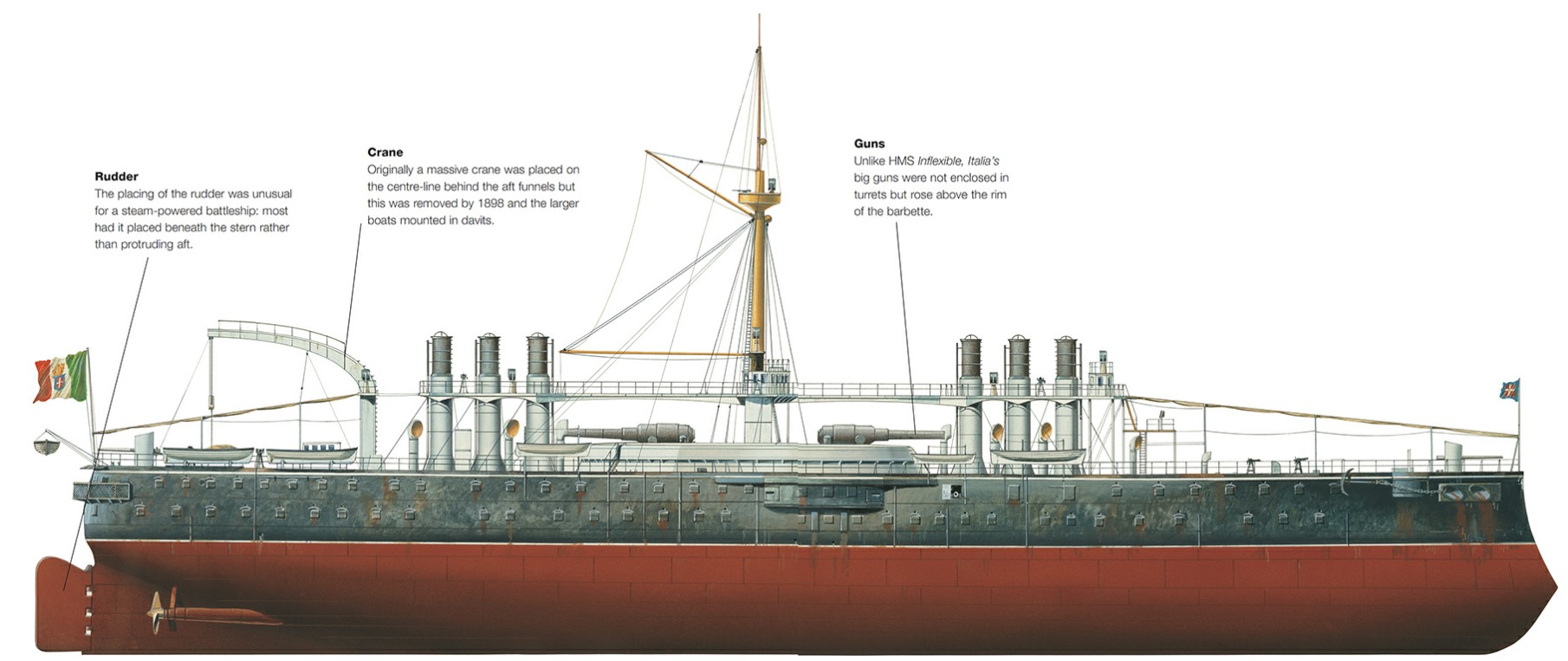
The frontal view shows the flying bridge, the elevated
forward control and navigation house, the sponsons, and the rounded hull shape.
From this deck plan the redoubt’s diagonal arrangement
is clear. There was an armoured deck just below waterline level, but no citadel
or side armour.
A novel battleship design, with four very large guns and no
side armour, in many ways Italia was a forerunner of the battlecruiser. For a
few years it held the prestige position of the largest and fastest battleship
in the world.
The Kingdom of Italy was declared in 1861 and from the start
it had difficult relations with the French and the Austrians. For Italy with
its long coasts and numerous islands, a naval force was a prime necessity, and
by 1866 it had fought one of the first ‘modern’ sea battles, against the
Austrian Navy at Lissa in the Adriatic Sea. That was a defeat despite superior
numbers on the Italian side, and drove the Italians to further expansion of
their fleet.
Fast and powerful
Laid down at Castellamare in 1877 and launched in 1880,
Italia took Brin’s revolutionary design of Duilio (1876) to an extreme. The
brief was for a very fast ship, heavily-armed, which could also carry a large
number of troops (at the time, France and Italy were on the verge of war over
Tunis, on the south coast of the Mediterranean Sea). As with Duilio, the guns
were mounted in echelon, but the main armament of Italia and its sister ship
Lepanto was of even heavier calibre, four 432mm (17in) guns each weighing 93
tonnes (103 tons), firing shells of 907kg (2000lb). The guns were mounted in a
huge barbette of oval shape extending beyond the sides, forming an armoured
redoubt set diagonally across the hull. Unlike the British Inflexible, it had a
high freeboard, 7.6m (25ft), offering more of a target to an enemy. The sides
carried no armour, but Italia relied on the power of its guns, and its high
speed, to avoid attack. Six funnels in sets of three, linked by high catwalks
with the conning tower, a lofty central mast, and a large curved crane on the
afterdeck, gave Italia a unique appearance. One of the few more traditional
features was an ‘admiral’s walk’ around the curved stern.
Fittings
The ship was built largely of steel, rather than iron.
Internally it had the now-standard armoured deck, curving upwards slightly from
the sides 1.83m (6ft) below the waterline, but above it a cellular raft ran the
entire length of the ship. The space between them was lined laterally with
cork-filled watertight cells separating the hull plating from an inner cofferdam
on each side, and two transverse levels, one of empty cells, with coal storage space
below. A double bottom was also fitted.
One novel feature of Duilio, not maintained on the new ship,
was a stern compartment for a torpedo boat, secured by watertight doors. Italia
also had space to hold an infantry division of 10,000 men and its equipment for
the relatively short Mediterranean crossing. The main guns could be
independently trained and aimed, but as with other very large guns of the time,
the rate of fire was slow, no more than one round every four or five minutes.
Construction of Italia and Lepanto stretched Italy’s new
warship-building resources, and the Italian government did not proceed to
enlarge its battlefleet further. But the size, speed and general innovation of
these Italian capital ships had a major impact on ship design and naval
planning in both the British and the French navies. Sir Nathaniel Barnaby,
Britain’s chief naval designer, observed that ‘We must … regard the first-class
ironclad as … being of over 14,000 tons if we accept the reasonings of the
Italian architects and the expression of their ideas in the Italia and
Lepanto’. In the mid-1880s British designers were still mulling over the kind
of ship ‘most suitable for meeting the Italia’. In this way the Italian
contribution was to push the greater naval powers towards greater size.
Rebuild
Between 1905 and 1908 Italia was rebuilt, losing two funnels
and with the tall single mast replaced by two, forward and aft of the funnels.
By this time battleship development had caught up and moved on. Improved armour
had disproved Brin’s theory that gun-power had made side-armour pointless, and
the formidable guns were sadly out of date. By the 1890s the ship really ranked
with armoured cruisers. The secondary armament was changed and reduced in
quantity. In 1909–10 it was used for torpedo training.
Still in commission during World War I, but renamed as
Stella d’Italia, it was based at Taranto and Brindisi for gunnery training
until 1917, when it was disarmed and transferred to the mercantile marine as a
grain transport. It was returned to the Regia Marina in 1921, but was almost
immediately sold for scrapping.
Specification
Dimensions
Length 124.7m (409ft), Beam 22.5m (74ft), Draught 8.7m (28ft
8in), Full load 10.1m (33ft)
Displacement 15,900 tonnes (15,654 tons)
Propulsion 24 boilers, 2 vertical compound engines
developing 11,780kW (15,797hp), twin screws
Armament
4 432mm (17in) breech-loading guns of 93 tonnes (103 tons),
7 150mm (5.9in) and 4 119mm (4.7in) guns, 4 356mm (14in) torpedo tubes
Armour
Redoubt 483mm (19in), Boiler uptakes 406mm (16in), Conning
tower 102mm (4in), Deck 102–76mm (4–3in)
Range 9260km (5000nm) at 10 knots
Speed 17.8 knots
Complement 701